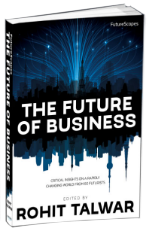16 May Millennial Finance and the Cashless Future
| Like 71% of others in the United States I’d rather spend time dealing with my dentist than my financial institutions. Well, my dentist is also my husband, so I guess in my case this is no surprise, but you get the point. As a millennialized generation X’er, I despise long hold times on the phone, the lack of an online chat (or even chatbot) function, the “too big to fail or even care about you” attitude, and their hopelessly dated web pages which prevent you from searching individual transactions or run useful book keeping analytics other than formats only compatible with expensive software like QuickBooks. American banks are lamented as being hopelessly behind the times and don’t seem to appeal to any generation after the Silents (b. 1921 – 1945).
So I’m not at all surprised when The Millennial Disruption Index claims that the banking industry is the industry ripest for disruption at the moment. One third of all Millennials believe that they will not need a bank in the future. Yet 90% have financial services relationships with a bank, which is actually 1% less than PayPal users (91%). As many as 73% of this cohort would be more excited about a new financial service offering from Google, Amazon, Apple, Square or PayPal than from their own financial institution. An interesting discovery is that legacy institutions – even banks, which are supposed to exude trustworthiness more than any other institution, can no longer convince the market base that they are up to snuff just by pointing to their experience or expertise. There’s been too many scandals and Panama Papers for that. Technology, not past performance helps bank win a younger market share. The annual growth rate for Fintech startups is around 46% and there are crazy valuations of these services that are not likely very sustainable. However, the qualities Millennials want from their financial institutions epitomize the shifts in business models we witness almost every time we hear about an industry being “disrupted”. Past performance metrics are not enough to win over younger consumers. Instead technological design, immediacy, transparency and disintermediation are the criteria that matter. Robo-investment platforms like Betterment and Wealthfront come to mind. New research also shows that when Millennials do trust or prefer larger banks it’s because of the technological offerings they can provide – not their tenure in the market. Surprisingly, JD Power’s survey found that the largest banks received the highest customer-satisfaction scores from younger adults, while older generations gave stronger marks to smaller institutions. It might seem that finally, the banks that used to give only lip service are now starting to put their money where their mouth is – hence they are able to capture younger audiences who haven’t yet had a chance to abandon them. This is happening despite the fact that people want to break up the big banks. Maybe convenience trumps the concern of being “too big to fail” after all? 74% of Millennials say mobile banking is very important to them (vs. only 42% of Boomers). And while 58% of Millennials still use cash, a majority of them believe the future is cashless. Sticking to cash is usually the effect of incorrectly assuming that there are fees tied in with using P2P payment systems like PayPal and Square. Venmo reports a growth of 200% per year among users who use their service, so it is only a matter of time before paying each other with cash is as passé as writing checks or doing almost anything with pen and paper besides doodling. Time is running out for established banks to catch up with this shift in this market. Banks need to look beyond other banks to find out where their competition is. Even Uber is a bank. As much as it has been seen as a transportation platform, Uber is an app for payment logistics and is planning to offer banking services to the drivers to satiate the company’s ravenous appetite for increasing its global market share. Are the banks ready? Can they adjust from being “too big to fail” to “nimble enough to survive”? And more importantly, what will these changes mean for innovators and small business owners? How do you think a cashless future would impact you? Image: El País, Foro No Money: The End of Cash, Madrid 2016
|


Sorry, the comment form is closed at this time.